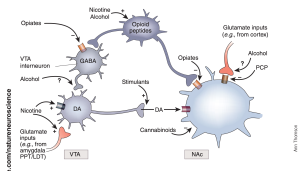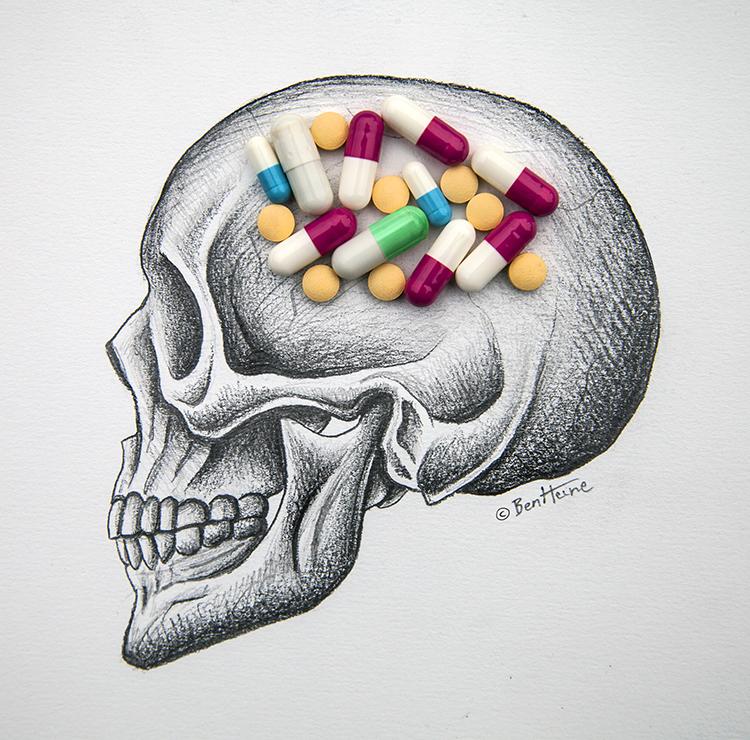What is Addiction?
Addiction is a dependency on a substance or activity, usually drugs of abuse, that is often motivated by the hope of escaping discomfort. This can include drinking an old fashioned every time you start to feel stressed in order to cope or lighting up a cigarette after having a long day. People turn to these drugs of abuse in order because the provide positive emotional responses that make the person feel like they are effectively coping with their negative emotions. But these substances have many negative effects on the brain that can permanently affect its functioning. This is why it is so difficult for people to quit once they have engaged in chronic use. It is also why relapse is so common amongst those suffering from addiction and why it can often take several tries at treatment for them to recover.
Pathology of Addiction
The primary source of addiction stems from the brains reward pathway. This pathway goes from the Ventral Tegmental Area (VTA) to the nucleus accumbens NAc with the primary neurotransmitter being dopamine (DA). Every drug of abuse either directly or indirectly increases DA expression between the VTA and the NAc. This results in positive feelings associated with the activity of taking said substance making you more likely to do it again in the future. When there is chronic use of drugs of abuse this causes permanent changes in these neuronal projections that cause tolerance, sensitization, and withdrawal symptoms.
Chronic use of drugs of abuse impairs the DA system making it more difficult for normally rewarding activates to have the same effect. If you usually love chocolate but then get addicted to cocaine after a while chocolate will no longer make you has happy as it once did. This is partially because of a decrease of tyrosine hydroxylase (TH),which is an enzyme important for DA synthesis, caused by chronic drug exposure. When TH is reduced it contributes to a reduction of DA available for signaling. This means that it will take higher doses of the substance to get the same effect producing tolerance. In a way this is your brain adapting to the upregulation of DA that drugs of abuse causes in an attempt to maintain homeostasis.

Nestler, E. J., (2005). Is there a common molecular pathway for addiction? Perspective: Neurobiology of Addiction 8(11). Doi:10.1038/nn1578
Sensitization is when the brain becomes more sensitive to certain neural projections. In other words it is easier for there to be a strong effect from DA projections. One contributor of sensitization is a protein called Delta-FosB, which accumulates in the NAc after chronic drug abuse. It has been found that as Delta-FosB accumulates in the NAc there is an increase in positive emotional expressions after DA expression. Meaning that it helps DA have a stronger effect to make you feel better.
Finally, there are withdrawal symptoms. Withdrawal is when you feel negative emotional and behavioral effects after stopping the use of a drug of abuse. There are a few factors that play into this phenomenon. The first is the impairment of the DA system due to tolerance. Chronic drug abuse causes changes to how cells function and these either don’t ever go away or take a very long time to recover. This is the case for impaired DA expression, when there is less of DA and the brain is struggling to make more things that normally make you happy no longer have that effect. Only the drug can produce the emotional effect that you are trying to achieve so many people relapse in order to feel better again. This process is aided by the corticotropin releasing factor (CRF) system. CRFs are a neuropeptide that is important for the brains stress response, and also play a role in how the brain copes with stress. During chronic drug use CRFs are released which creates the negative feelings often felt after drug use. When a drug is chronically abused this taxes the CRF system. Once a person decides to stop use of the substance the brain is still trying to release CRFs as part of the coping process for the stress that it is under. But the neurons can’t produce CRFs as fast as they are being released. This means that the brain is physically incapable of coping with the stress that it is under. Resulting in negative emotional and behavioral responses. These negative responses make the brain want to return to use of the substance in order cope with its stress response.
References
Nestler, E. J., (2005). Is there a common molecular pathway for addiction? Perspective: Neurobiology of Addiction 8(11). Doi:10.1038/nn1578
https://www.health.harvard.edu/blog/what-is-addiction-2-2017061914490
